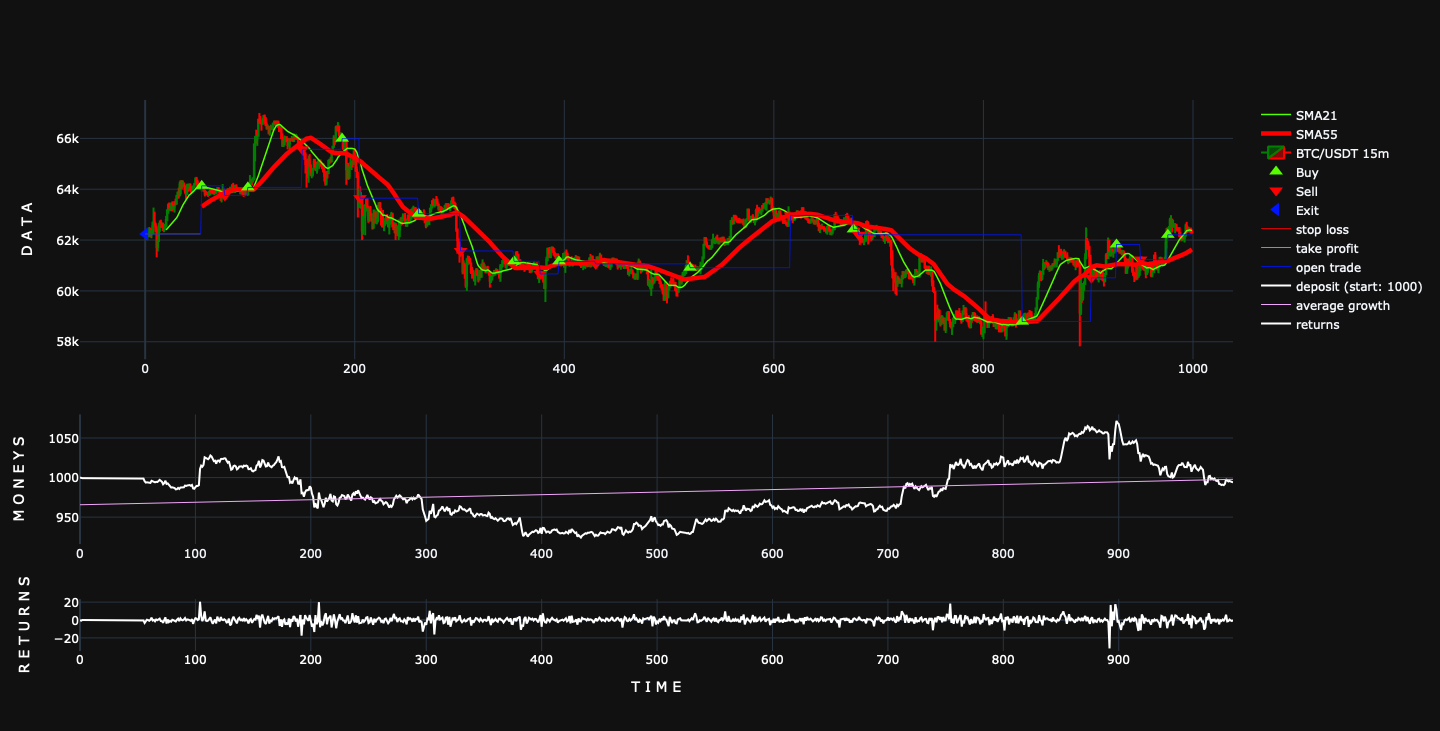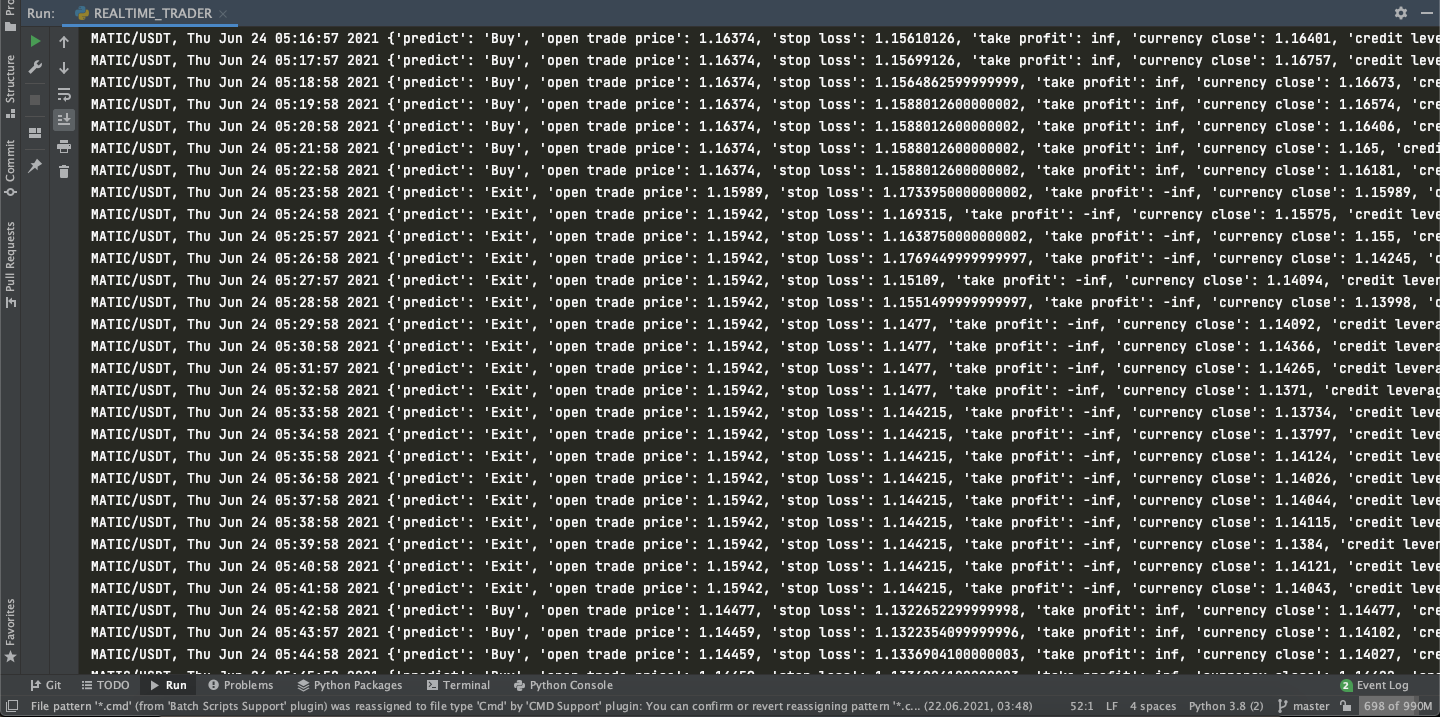Library for easy management and customization of algorithmic trading.
Project description
quick_trade
View documentation: 🚧 https://vladkochetov007.github.io/quick_trade/#/ 🚧 in process
old documentation (V3 doc): https://vladkochetov007.github.io/quick_trade.github.io
used:
├──ta by Darío López Padial (Bukosabino https://github.com/bukosabino/ta)
├──plotly (https://github.com/plotly/plotly.py)
├──pandas (https://github.com/pandas-dev/pandas)
├──numpy (https://github.com/numpy/numpy)
├──tqdm (https://github.com/tqdm/tqdm)
└──ccxt (https://github.com/ccxt/ccxt)
Algo-trading system with python.
Customize your strategy!
import quick_trade.trading_sys as qtr
from quick_trade import brokers
from quick_trade.plots import QuickTradeGraph, make_figure
import yfinance as yf
import ccxt
class MyTrader(qtr.Trader):
def strategy_sell_and_hold(self):
ret = []
for i in self.df['Close'].values:
ret.append(qtr.utils.SELL)
self.returns = ret
self.set_credit_leverages(1.0)
self.set_open_stop_and_take()
return ret
a = MyTrader('MSFT/USD', df=yf.download('MSFT', start='2019-01-01'))
a.connect_graph(QuickTradeGraph(make_figure()))
a.set_client(brokers.TradingClient(ccxt.ftx()))
a.strategy_sell_and_hold()
a.backtest()
Find the best strategy!
import quick_trade.trading_sys as qtr
import ccxt
from quick_trade.quick_trade_tuner import *
from quick_trade.brokers import TradingClient
class Test(qtr.ExampleStrategies): # examples of strategies
def strategy_supertrend1(self, plot: bool = False, *st_args, **st_kwargs):
self.strategy_supertrend(plot=plot, *st_args, **st_kwargs)
self.set_credit_leverages()
self.convert_signal()
return self.returns
def macd(self, histogram=False, **kwargs):
if not histogram:
self.strategy_macd(**kwargs)
else:
self.strategy_macd_histogram_diff(**kwargs)
self.set_credit_leverages()
self.convert_signal()
return self.returns
def psar(self, **kwargs):
self.strategy_parabolic_SAR(plot=False, **kwargs)
self.set_credit_leverages()
self.convert_signal()
return self.returns
params = {
'strategy_supertrend1':
[
{
'multiplier': Linspace(0.5, 22, 5)
}
],
'macd':
[
{
'slow': Linspace(10, 100, 3),
'fast': Linspace(3, 60, 3),
'histogram': Choise([False, True])
}
],
'psar':
[
{
'step': 0.01,
'max_step': 0.1
},
{
'step': 0.02,
'max_step': 0.2
}
]
}
tuner = QuickTradeTuner(
TradingClient(ccxt.binance()),
['BTC/USDT', 'OMG/USDT', 'XRP/USDT'],
['15m', '5m'],
[1000, 700, 800, 500],
params
)
tuner.tune(Test)
print(tuner.sort_tunes())
tuner.save_tunes('quick-trade-tunes.json') # save tunes as JSON
You can also set rules for arranging arguments for each strategy by using _RULES_ and kwargs to access the values of the arguments:
params = {
'strategy_3_sma':
[
dict(
plot=False,
slow=Choise([2, 3, 5, 8, 13, 21, 34, 55, 89, 144, 233, 377, 610, 987, 1597]),
fast=Choise([2, 3, 5, 8, 13, 21, 34, 55, 89, 144, 233, 377, 610, 987, 1597]),
mid=Choise([2, 3, 5, 8, 13, 21, 34, 55, 89, 144, 233, 377, 610, 987, 1597]),
_RULES_='kwargs["slow"] > kwargs["mid"] > kwargs["fast"]'
)
],
}
Installing:
$ git clone https://github.com/VladKochetov007/quick_trade.git
$ pip3 install -r quick_trade/requirements.txt
$ cd quick_trade
$ python3 setup.py install
$ cd ..
or
$ pip3 install quick-trade
User's code example (backtest)
import quick_trade.trading_sys as qtr
import ccxt
from quick_trade import brokers
from quick_trade.plots import make_figure, QuickTradeGraph
client = brokers.TradingClient(ccxt.binance())
df = client.get_data_historical('BTC/USDT', '15m', 1000)
trader = qtr.ExampleStrategies('BTC/USDT', df=df, interval='15m')
trader.set_client(client)
trader.connect_graph(QuickTradeGraph(make_figure(height=731, width=1440, row_heights=[10, 5, 2])))
trader.strategy_2_sma(55, 21)
trader.backtest(deposit=1000, commission=0.075, bet=qtr.utils.np.inf) # backtest on one pair
Output plotly chart:
Output print
losses: 7
trades: 16
profits: 9
mean year percentage profit: 541.9299012354617%
winrate: 56.25%
Run strategy
Use the strategy on real moneys. YES, IT'S FULLY AUTOMATED!
import datetime
from quick_trade.trading_sys import ExampleStrategies
from quick_trade.brokers import TradingClient
from quick_trade.plots import QuickTradeGraph, make_figure
import ccxt
ticker = 'MATIC/USDT'
start_time = datetime.datetime(2021, # year
6, # month
24, # day
5, # hour
16, # minute
57) # second (Leave a few seconds to download data from the exchange and strategy.)
class MyTrade(ExampleStrategies):
def strategy(self):
self.strategy_supertrend(multiplier=2, length=1, plot=False)
self.convert_signal()
self.set_credit_leverages(1)
self.sl_tp_adder(10)
return self.returns
keys = {'apiKey': 'your api key',
'secret': 'your secret key'}
client = TradingClient(ccxt.binance(config=keys)) # or any other exchange
trader = MyTrade(ticker=ticker,
interval='1m',
df=client.get_data_historical(ticker, limit=10),
trading_on_client=True)
fig = make_figure()
graph = QuickTradeGraph(figure=fig)
trader.connect_graph(graph)
trader.set_client(client)
while True:
if datetime.datetime.now() >= start_time:
break
trader.realtime_trading(
strategy=trader.strategy,
ticker=ticker,
coin_lotsize_division=True,
limit=100,
ignore_exceptions=False,
wait_sl_tp_checking=5
)
License
quick_trade
by
Vladyslav Kochetov is licensed under a
Creative Commons Attribution-ShareAlike 4.0 International License.
Project details
Release history Release notifications | RSS feed
Download files
Download the file for your platform. If you're not sure which to choose, learn more about installing packages.
Source Distribution
quick_trade-6.4.6.tar.gz
(28.9 kB
view hashes)

















